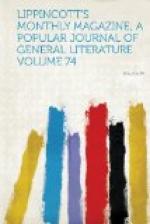One of the most extraordinary persons who ever occupied the position of provost, or indeed any position, was John Hely Hutchinson. He was a man of great ability, and perfectly determined to succeed, without being troubled with any very tiresome qualms as to the means he employed in the process. Such an officeholder as this man the world probably never saw. He was at the same time reversionary principal secretary of state for Ireland, a privy councilor, M.P. for Cork, provost of Trinity College, Dublin, major of the fourth regiment of horse, and searcher of the port of Strangford. When he was appointed provost—a situation always filled since the foundation by a bachelor—there was great indignation amongst the fellows, and to appease them he ultimately procured a decree permitting them to marry—a privilege which they, unlike their brethren at Oxford and Cambridge, enjoy to this day. His position as provost did not prevent his righting a duel with a Mr. Doyle, but neither was hurt. Mr. Hutchinson had a great dislike to a Mr. Shrewbridge, one of the junior fellows, who had shown opposition to him. Mr. Shrewbridge died, and the under—graduates attributed his death to the provost’s having refused him permission to go away for change of air. A thoroughly Hiber-man emeute was the consequence. The provost ordered that the great bell, which usually tolls for a fellow, should not toll, and that the body should be privately buried at six A.M. in the fellows’ burial-ground. The students immediately posted up placards that the great bell should toll, and that the funeral should be by torchlight. They carried the point. Almost all the students attended the corpse to the grave in scarfs and hatbands at their own expense, and when the funeral oration was pronounced they flew in wild excitement to the provost’s house, burst open his doors and smashed the furniture to pieces. The provost had a hint given him, and with his family had retreated to his house near Dublin. It was subsequently stated on good authority that Mr. Shrewbridge could not in any case have recovered.
Any one who takes an interest in the most original writer—not to say, man—of the eighteenth century will not fail to find his way to “the Liberties,” as that queer district is called which surrounds St. Patrick’s Cathedral. Some years ago the present writer made his way into the great deserted deanery—the then dean resided in another part of the city—got the old woman in charge of the house to open the shutters of the dining-room, and gazed at the original portrait of Jonathan Swift, which hangs there an heirloom to his successors. Of the precincts of his cathedral he writes to Pope: “I am lord-mayor of one hundred and twenty houses,[5] I am absolute lord of the greatest cathedral in the kingdom, and am at peace with the neighboring princes—i.e., the lord-mayor of the city and the archbishop of Dublin—but the latter sometimes attempts encroachments on my dominions, as old Lewis did in Lorraine.”




